
Goats in Medicine: 1 2 3 4 Next>>
Goats in Medicine During the Golden Age of Piracy, Page 1
"The Goat. The Parts in Use of this Animal are the Blood, the Marrow, the Suet, the Milk, the Whey, the Stones in the Stomach, the Dung, the Urine, the Bladder, the Omentum [a fold of skin surrounding the internal organs that stores fat], the Skin, and the Gall. " (Robert James, Pharmacopœia universalis, p. 497)
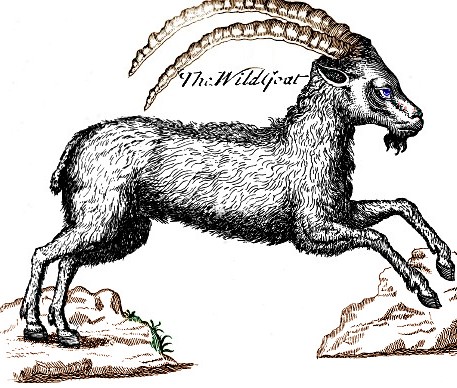
The Wild Goat, Taken from
The History of Druggs, by Pierre Pomet, 3rd ed., p. 257
The use of goats in period medicine was quite broad; you almost get the impression that any part that wasn't used for food could be adopted by the apothecaries of the time.
French apothecary Pierre Pomet went on for pages about the various parts of the goat that could be used in medicine. Among other curious observations, he explained, "The Horns and Hoofs of these Creatures abound with a great deal of volatile Salt, Oil, and Spirit, which are equally useful with the Preparation from Harts-horn."1 He also explains that a "volatile Oil drawn from the Brain of the Goat, and well rectified [purified through repeated distillation], is compared with Goddard's Drops [a concoction patented by Jonathan Goddard given for fainting, apoplexy [unconciousness], lethargy and similar problems2], that made such a Noise in the Reign of King Charles the Second, and may very likely answer as well, since that Medicine was no more than an exaulted volatile Oil, as this is, and so may be rank'd in the same Class."3
Other physicians and surgeons didn't suggest harvesting the oil of the brain of a goat, however. So we're going to focus on the more common bits suggested - some of which you may find only slightly less unusual than that last example.
1 Pierre Pomet, The Compleate History of Druggs, 3rd Edition, p. 259; 2 Johnathan Goddard, Dictionary of National Biography, 1885-1900, Volume 22, from wikisource, gathered 4/10/13; 3 Pomet, p. 259-60
The Bezoar Stone
"Bezoar Stone. A sort of calculus found in the stomachs of ruminating animals, and formerly sold as it is now in the East, at a high price, as a cordial and restorative. Its virtues, it is probable, are in a great measure fabulous. (Robert James, Pharmacopœia universalis, p. 486)
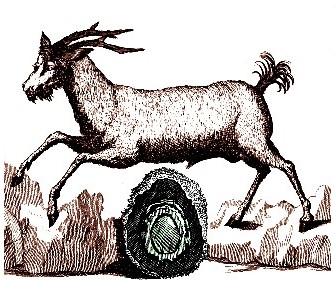
A Wild Goat with Bezoar Stone Inset, Taken from
The History of
Druggs, by Pierre Pomet, 3rd ed., p. 257
Medicine from the late 14th century through the late 18th century could be said to have one foot in the writings of the ancient medical practitioners of centuries and even millennia before it and another in the logic inherent in scientific methodology. Folk remedies were still in wide use all during this period, which is where the bezoar stone finds its roots.
Its origins as a medicine are uncertain, but its reputation as an alexipharmic seems to have come from Persia. In a book about his travels, Friar Domingo Navarrete recounts the following story.
[The local hunters] hit a Deer with a forked Arrow, which stuck in him and he alive. Some time after they kill’d him, and found the forked point of the Arrow in its proper shape but all overgrown with Bezoar; they broke off the point, and through it the Iron appear’d, to the admiration of all that beheld it. Now the Iron of the Arrow heads is poisoned, and so they concluded that Bezoar-stone, because it had hindred the poison of the said Arrow from taking effect, must needs be an excellent Antidote against any Poison.1
Whether Navarette's is the original story that led to the fame of the bezoar stone or not, this product of goats and other animals was widely held to be an alexipharmic (a medicine that served as an antidote to poison.) Nearly every period physician and surgeon who discusses it mentions this property. In fact, Wikipedia tells us,

Photographer: F. Spangenberg
A Bezoar Ibex, Found Throughout the Persian Empire
"The word 'bezoar' comes from the Persian pād-zahr (پادزهر), which literally means 'antidote'."2
Yet not everyone had faith in this folk remedy. For example, in the quote that leads this section, Robert James calls the bezoar's attributed properties 'fabulous', by which he means they are vastly overstated. As he explains later on in his description of the bezoar stone, "we have no Instances from Experience to support [the claims about it's usefulness in medicine]. It has neither Smell nor Taste; and upon taking into the Stomach, gives no Sensation, nor produces the least perceivable Effect, which is Ground enough to suspect it good for nothing"3.
Still, the bezoar is interesting because it presents not only an example of how this product of goats was used in medicine, it is also a fascinating window into medicine and medicinal theories of the period.
So we're going to look at it in depth, examining period explanations of its properties, its uses in medicine, the locations where it was harvested, its value during the time, how it was counterfeited and finally ways that period physicians tried to debunk the myth of the bezoar stone's medicinal properties.
1 Domingo Navarrete, The Travels and Controversies of Friar Domingo Navarrete 1618-1686, p. 98; 2 Bezoar, Wikipedia, gathered 3/29/13; 3 Robert James, Pharmacopœia universalis, p. 487;
The Bezoar Stone - Properties
Several period authors go into great detail about the different sorts of bezoars, how they looked, felt and smelled and the way in which they were created.
There were two different types of bezoar mentioned: the occidental and the oriental. Pierre Pomet explains. "The first Kind, or that most commonly us'd, is call'd Lapis Bezoar Orientalis, or the Oriental Bezoar... The second Bezoar is call'd Lapis Bezoar Occidentalis, or Occidental Bezoar"1. Different authors ascribe different properties to each type. Pomet explains that the occidental bezoar "has the same Virtues with the other, but much weaker"2, while Robert James explains that the virtues of the occidental "are much the same, as those ascrib'd to the Oriental Bezoar."3
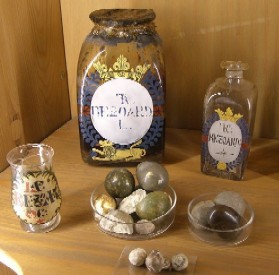
Photographer:
Gerhard Eisner
Various Bezoar Stones & Containers - at the German
Pharmacy
Museum in Heidelberg Castle
James explains that both types of bezoars are generally "of different Shapes and Sizes: Some of them are of the Form of a Kidney, or French Bean; others are round, oblong, and of an irregular Figure."4 However Pomet differentiates in sizing between the orient and occidental, explaining, "The occidental Bezoar... is usually much larger, being found sometimes of the Size of a small
Hen's Egg."5 He further explains that some oriental bezoars "are as big as a Wall-nut, others as a Nutmeg, others as a Hazel-Nut, and some as a large Pea"6. Ambroise Parė suggests the oriental bezoar was typically the size and shape of "an Acorn or Date-stone"7.
Pomet explains these differences in shape by the plant that the goats munch on which he believes is the catalyst for bezoar creation. As he tells it, is is around "the Ends of the Brances which the Goats eat, [that] the Bezoar forms itself in the Belly of these Animals. They take their Shape from that of the Buds and the Ends of the Branches, which is the Reason they are of so many different Figures."8
While size seems to have been an important factor in valuing a bezoar, none of the authors suggest it made any difference in the medicinal values of the stone. While discussing the oriental bezoar, Pomet notes that "[t]he largest are the most valued by the Curious, but it is of little Moment in Physick of what Size they are."9
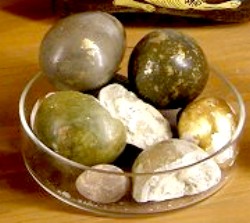
Photographer:
Gerhard Eisner
Detail of Bezoar Stone Colors from the German
Pharmacy
Museum in Heidelberg Castle
Robert James finds that bezoars are generally "form'd of a greenish or Olive colour'd Substance, diversify'd with white Streaks, which run thro' the whole Body of the Stone"10 although he later notes that an occidental bezoar "is easily known from the Oriental, from its being of a paler Colour: It is sometimes of a greyish white"11. Pare says that the oriental bezoar "is somtimes of a sanguine color, and other whiles of a bonie-like or yellowish color but most frequently of a blackish or dark green resembling the color of mad Apples, or els of a Civet-Cat."12 Pomet weighs in, stating that the oriental is "of an Olive or grey Colour"13, while the occidental is "of diverse Colours, but most commonly of a light Grey... [or] of an ash or whitish Colour."14
With regard to texture, Pomet advises the medical practitioner, "Chuse your Oriental Bezoar one whole Stone, that is smooth, [and] shining" also advising that it be "polish'd"15. The occidental bezoar, he explains,
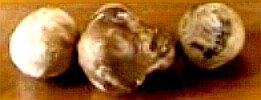
Photographer:
Gerhard Eisner
Detail of Textures of Bezoars at the German
Pharmacy
Museum in Heidelberg Castle
will typically be "not so slick and shining... and the Bottom is soft, and very smooth, of a reddish grey Colour"16. Parė explains that "this stone is light and not verie hard, but so that it may easily be scraped or rasped like alabaster, so that it will dissolve, beeing long macerated in water"17. To this, Robert James adds that the bezoar can be "broken between the Teeth, to which they adhere like a gently glutinous Substance, and tinge the Saliva a little."18
Pomet also talks about the scent of the bezoar. He explains that the oriental bezoar is "of a pleasant Smell, inclining to Ambergrease"19 while noting that the occidental bezoar "has also a very sweet Smell, and is much stronger than the Oriental Bezoar."20
1 Pierre Pomet, The Compleate History of Druggs, 3rd Edition, p. 237; 2 Pomet, ibid.; 3 Robert James, Pharmacopœia universalis, p. 487; 4 James, p. 486; 5 Pomet, p. 236-7; 5 Pomet, p. 237; 7 Ambroise Paré, The Workes of that Famous Chirurgion Ambrose Parey, p.529; 8 Pomet, p. 237; 9 Pomet, ibid.; 10 James, Ibid.; 11 James, p. 487; 12 Paré, ibid.; 13 Pomet, ibid.; 14 Ibid.; 15 Ibid.; 16 Ibid.; 17 Paré, ibid.; 18 James, p. 486; 19 Pomet, ibid.; 20 Pomet, ibid.
The Bezoar Stone - Makeup
"[The bezoar] grow's by little and little about a straw or some such like substance in scales like to scales of an onion, so that when as the first scale is taken off, the next appear's more smooth and shining as you still take them away, the which amongst others is the sign of a good Bezoar and not adulterate." (Ambroise Paré, The Workes of that Famous Chirurgion Ambrose Parey, p.529)
Because it is built up over time, the bezoar contains layers. Pomet explains this as being "made
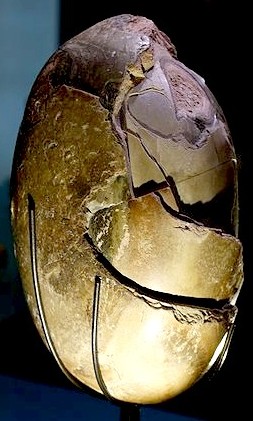
Photographer:
M0tty
Exposed Layers of a Bezoar Stone
up of several Laminæ or Crusts, laid of one over another like the former, but much thicker, and being broke, appears as if it had been sublimed, in that one sees a great many little Needles shooting like those in Salt of Lead"1. He further explains that the layers "are form'd successively by different Accessions of saline Humours, which petrify in
the Belly of the Animals ...which continually leave behind them certain Salts, which coagulate and form themselves into a hard Crust or Stone."2
Robert James says the "Laminæ adhere so closely to one another, that breaking the Stone, we may observe several Layers of different thicknesses, and even sometimes of different Colours. There are also found Laminæ, which upon breaking these Stones, disengage and separate themselves very regularly from each other; which they also do, when a considerable Degree of Heat is apply'd to them."3
Pomet finds that the layers of the oriental bezoar are, "of a grey or olive Colour."4 Both he and James note that the layers of the occidental bezoar are thicker, with James finding that the occidental layers are "straited according to their Thickness"5 and Pomet noting that the occidental laminae are "interspersed with a great many small Points on the Inside."6
After the outer layers are removed, Paré says the bezoar "hath no heart nor kernel in the mid'st, but powder in the cavitie thereof, which is also of the same facultie [use]."7 James explains that this 'powder' in the center "is usually hard, gravelly, and pretty smooth."8 The material in the center does not seem to be regarded as being more or less desirable as a medicament than the rasped layers, however.
1 Pierre Pomet, The Compleate History of Druggs, 3rd Edition, p. 237; 2 Pomet, ibid.; 3 Robert James, Pharmacopœia universalis, p. 486; 4 Pomet, ibid.; 5 James, p. 487; 6 Pomet, ibid.; 7 Ambroise Paré, The Workes of that Famous Chirurgion Ambrose Parey, p.529; 5 James, p. 486
The Bezoar Stone - Where Found
In general, the oriental stones seem to have mostly come from the cities along the trade route to the East Indies, particularly from Persia and other Arabic countries while the occidental appear to have come from South America.
Ambroise Paré talks about an oriental bezoar that came from "Persia ...and a certain part of India [where there is] a certain kinde of Goat called a Pazaïn... the color of this beast is commonly reddish, the height thereof indifferent, in whose stomach concrete's the stone called Bezoar"1. However, he later mentions a bezoar given to the King Charles of France which was "brought out of Spain."2 Robert James agrees with Paré's initial assessment, advising,"The best Species of these Stones are taken from Animals that feed on large Mountains such as those of Persia."3
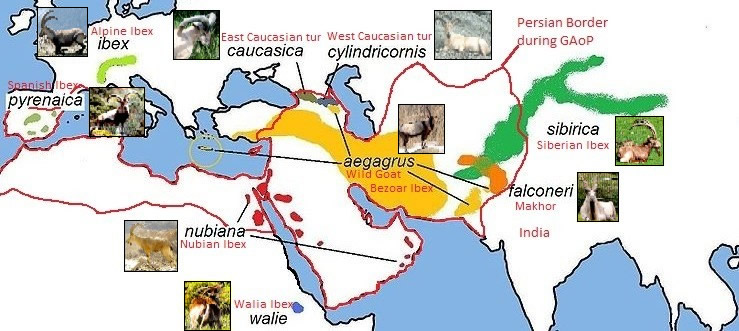
Location of Goats in the Middle East Where the Best Bezoar Stones Were Found
Pierre Pomet says that oriental bezoars were "produc'd in the East-Indies, which they call, in Latin, Capricerva, because they partake of the Deer and the Goat."4 He further identifies them as being a product of "a Province of the Kingdom of Galconda [Golkonda, India] lying on the North East."5 While traveling in the East Indies in a region he calls 'Tatta' [most likely in India], Merchant captain Alexander Hamilton detailed the production of the region which included the "Goat Bezoar"6. Similarly, while listing the output of Borneo in 1685, Abraham Crowly notes that they have "here an abundance of excellent Bezar Stones"7.

A Llama in Peru. They are also able to
produce
bezoar stones. (You were sick of
images of goats, Weren't You?)
Pomet explains that the occidental bezoar "is brought from Peru, where it is found in some Goats, Harts, or those Animals that produce the Bezoar, And as they are but rarely met withal in the Belly of these Animals, that makes it, that very few are brought into France."8 The only other reference I have to place producing bezoars in South America comes from privateer captain Edward Cooke's book which lists "several Creatures in whom the Bezoar Stone is found" in Guatamala.9
Perhaps what is most fascinating about this is how the accessibility to sea travel made this mythical poison cure-all more valuable. When we consider pirates and privateers, we often think of them trying to take gold. While it was was certainly one of the most desired cargos, the opening of the world to trade via the sea made other things such as foreign spices and medicines more available and valuable to Europe. It also fed the natural desire of humanity to find better medicines and even to put their hopes into cure-alls such as the bezoar and ambergris. No period author mentions bezoars harvested from goats in England, although they likely existed. Yet even the skeptical James explained that the best stones came from goats who lived in the mountains, specifically in Persia.
1 Ambroise Paré, The Workes of that Famous Chirurgion Ambrose Parey, p.529; 2 Paré, ibid.; 3 Robert James, Pharmacopœia universalis, p. 486; 4 Pierre Pomet, The Compleate History of Druggs, 3rd Edition, p. 237; 5 Pomet, p. 235; 6 Alexander Hamilton, British sea-captain Alexander Hamilton's A new account of the East Indies, 17th-18th century, p. 115; 7 William Ambrosia Cowley, "Cowley’s Voyage Round the Globe" from William Hacke’s book A collection of original voyages, p. 25; 8 Pomet, p. 237; 9 Edward Cooke, A Voyage to the South Sea and Round the World in the Years 1708 to 1711, p. 371

